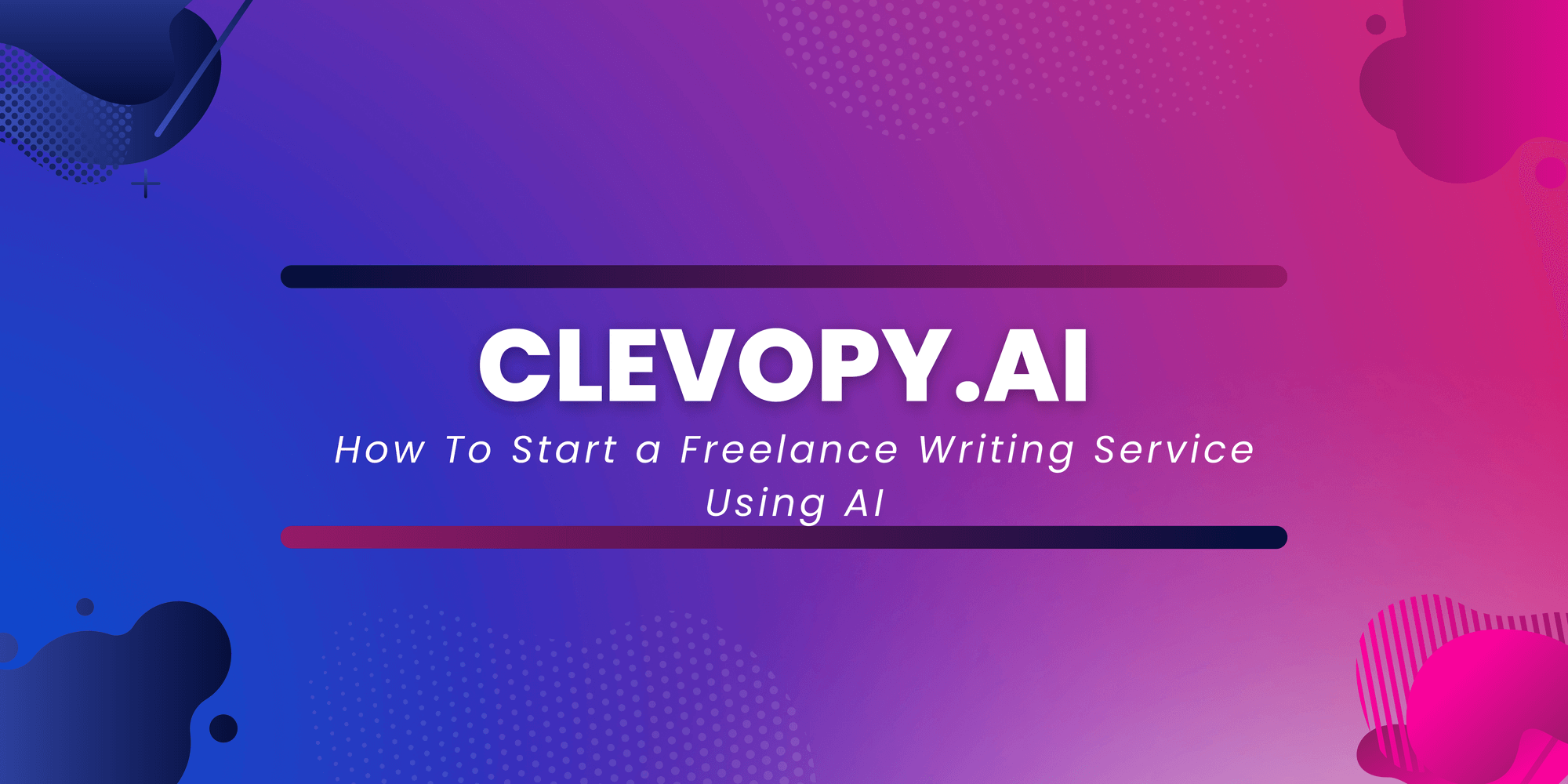Starting a freelance writing service using AI can be an exciting and satisfying experience.
First, you will need to decide on the types of services you plan to offer. You may want to specialize in SEO-friendly content, blog articles, or feature pieces for magazines; whatever you decide, make sure your services meet the needs of your clients.
Next, begin researching relevant Artificial Intelligence tools that could help you in your work. Many platforms provide features like natural language processing or text analysis that can automate different aspects of content writing and save you time.
You may also want to consider tools that help with editing and proofreading; these can give your clients an extra level of confidence in your work. Once you have chosen the tools that fit your needs, it’s time to start marketing yourself as an AI-powered freelance writer.
There are numerous online platforms where potential clients can find writers, such as Upwork or Fiverr. Spend some time creating a professional profile and portfolio that shows potential clients what you can do and how AI helps improve your work.
Here are some tips on getting started:
Make A Decision On What Type Of Content You Want To Create
Decide what type of content you want to provide to potential clients. Do you want to write blog posts, web copy, or even white papers?
This will help determine the types of AI-enabled tools you'll need. Build a list of different content verticals and the types of content pieces that fit the particular audience.
This could include AI Solutions like; Clevopy.ai, WriteSonic, Grammarly, Autocorrect, Jasper, rytr, or Copy.ai. It is important to consider what type of content you plan on producing, how many people will be working together on it, and how much automation you would like.
Start Researching The AI Tools That Works For You
When researching AI tools that work for you, the first step is to define what kind of functionality you need. This could include automation, natural language processing, machine learning capabilities, or other sophisticated features.
Once you have a clear understanding of the type of functionality you require in an AI tool, it is time to start your research.
A great way to begin your research is by looking at existing products and services in the market.
Check out online reviews and testimonials from customers who have used similar products to get a better understanding of which features may be most advantageous for your needs. You can also read up on industry news and reports related to AI technologies to learn more about the current trends.
Overall, researching AI tools requires patience and dedication. To ensure you find a product that meets your exact requirements, take time and do plenty of research before making any decisions.
Additionally, don’t forget to reach out directly to companies offering AI solutions directly so you can ask them questions and gain more insight into their offerings. With all these steps in mind, you should be well on your way toward finding an optimal AI tool for your needs.
Create Templates for Your Content
After selecting the correct software, you can begin creating templates that will be used to create consistent content. This includes general topics for articles and other works as well as specific information about format and structure.
Templates are perfect for documents that you'll update regularly or need to quickly modify, like newsletters, marketing emails, or webpages.
First, decide on the common template elements that will make up each document. The most basic template should include a header with your branding or logo, some space for images and graphics, and sections for text. It's important to think about how visuals will fit in the layout as you plan out your template.
Once the structure is in place, start customizing the design with fonts, colors, and other elements like borders or shadows. Consider what design choices fit best with your brand’s visual identity and will help to present your message in an engaging way.
Test out different variations of the template by filling it with dummy text or images. This last step ensures that all elements of your final template look great when put into practice.
Research And Find Potential Clients Who Need Content
The first step in finding potential clients who need content is conducting research. This research can be conducted online, through networking, or by reaching out to other content creators and asking if they know anyone who is looking for content.
Furthermore, researching the target audience of the content creator can provide valuable insights into what type of client might need their services.
To start researching potential clients, consider using search engines such as Google or Bing, or use AI Chatbots and Research Tools.
Searching keywords related to the topic that the content creator specializes in can help them discover websites that may be interested in their services.
Additionally, there are several tools available such as LinkedIn's Advanced People Search tool that allow users to search for companies that fit specific criteria.
Networking with other professionals in the industry can often prove to be a great way to find potential clients. Joining groups related to the topic or attending any events or conferences can help to create connections which may lead to opportunities down the line.
Reaching out directly on social media platforms such as Twitter and Instagram can also be a good way to make new contacts.
Talking with other content creators and asking if they know anyone who is looking for quality content can provide useful leads as well. Many times these colleagues will already have established relationships with people who could benefit from their services.
Implement Your Payment System
To implement a payment system, the first step is to sign up with a third-party processor, such as PayPal or Stripe. From here, you will be able to create an account and set up your payment system.
Depending on the processor used, you may have to supply additional information, such as your bank details.
Next, you will need to integrate the payment processor into your website or app if necessary. This process often requires programming experience and may require different steps depending on which processor is being used.
Once the integration is complete, customers will be able to make payments through the chosen payment gateway.
After setting up and integrating the payment system, you'll need to configure it for use. This involves setting up taxes (if applicable), processing fees, and any other customizations needed for your particular business model.
You may also need to consider whether or not you want to accept certain types of payments such as credit cards and e-checks.
Once everything is set up and configured correctly, you will be ready to go live with your payment system.
At this stage, customers can begin making payments with confidence that their information is securely processed and stored in accordance with industry standards.
Design A Website Or List Your Skills on Writing Platforms
Create a website for yourself as a writer and set up pages for each of your offerings so that potential clients can learn more about your services. So how do you create a good functioning website?
- Knowledge of web design software and coding languages, such as HTML, CSS, and JavaScript.
Web design software and coding languages such as HTML, CSS, and Javascript are valuable tools in today's digital landscape.
- HTML (Hypertext Markup Language) is the foundation of web design. It defines the structure of a website with elements such as titles, headings, paragraphs, images, and links.
- CSS (Cascading Style Sheets) is used to shape webpages' appearance by defining things like font size and color.
- Javascript is a scripting language used to interact with the user or create dynamic content on web pages.
To use these programming languages effectively, designers must have knowledge of syntax and structure so that they can write code accurately.
They should also know about principles like accessibility and responsive design so that they can create websites for different types of devices, browsers, and users.
Finally, understanding how to debug code is essential as it allows developers to find bugs and make necessary changes quickly.
2. Fluency in graphic design principles and building attractive, user-friendly layouts.
Graphic design principles and creating attractive, user-friendly layouts are at the heart of successful graphic design.
Fluency in graphic design principles helps to create harmony between components, making visual designs that are functional as well as aesthetically pleasing.
- This requires a keen eye for color, balance, texture, spacing, alignment, typography, shape, and form. It also involves understanding the psychology of color and how it can influence perception.
- When it comes to layout design for user interfaces (UI), fluency in graphic design principles becomes even more important. A UI designer must have a good understanding of composition and be able to arrange visual elements in a way that is visually attractive but also make sure everything is organized clearly while being easy to navigate.
For example, when creating menus it needs to be clear what each option does when selected but also look aesthetically pleasing.
To develop a strong level of fluency in graphic design principles one must have an understanding of the key concepts of design and practice implementing them over time.
- Becoming knowledgeable in industry-standard tools such as Adobe Photoshop and Illustrator is also essential for success.
- Building an eye for detail will help improve efficiency when creating layouts from scratch or editing existing ones. It’s important not only to understand graphic design concepts but apply them in meaningful ways.
Understanding of How Search Engine Optimization Works and How to Create Content that is Optimized for Ranking
Search engine optimization (SEO) is a set of strategies and techniques used to increase the visibility of a website in organic search engine results.
It involves creating content that is relevant to the topics that users are searching for, optimizing elements on the website such as titles, meta tags, and images, building backlinks from other websites, and using analytics data to track user behavior on the site.
By optimizing these elements and making sure that your content is relevant to what people are searching for, you can help boost your website's ranking in search engines.
Creating content optimized for ranking starts with understanding what topics your target audience is actually interested in. Once you have identified those topics, you should create helpful content about them that offers real value to readers.
This could be written articles with keyword-rich titles and meta descriptions or videos detailing your products or services. Make sure that the content is comprehensive enough so that it answers all of the questions related to the topic.
In addition to writing quality content, it’s also important to optimize elements on each page for SEO purposes.
This includes making sure each page has an appropriate title tag, meta description, and ALT text on any images included on the page. You should also use keywords throughout the page so that search engines can attribute relevance to them when indexing your site.
Building backlinks from authoritative websites can also help you rank higher in search results.
A backlink is a link from another website pointing at yours – generally speaking, the more respected sites link out to yours, the better your search rankings will become over time.
Finally, analyzing user behavior data can help you understand which pages are performing best and why—a key part of SEO strategy.
Using analytics tools such as Google Analytics allows you to track user interactions with your site and make necessary adjustments based on this data to ensure visitors are finding what they need quickly.
Ability to Collaborate with a Team or Work Independently to Carry out the Design Process from Concept to Completion
In terms of collaboration, you can work with other professionals such as designers, engineers, and marketers to create an effective and efficient design workflow.
In addition to providing creative ideas and suggestions, use communication skills to motivate team members and foster collaboration among them.
Understand how important it is to create a unified approach towards a common goal.
Comfort Using Analytics Tools to Measure Site Performance and Track Visitor Engagement
Analytics tools play an important role in measuring the performance of a website and tracking visitor engagement. Knowing how guests use and interact with your website helps you identify potential opportunities to provide better digital experiences.
By utilizing analytics tools, you can gain insights into user behavior on your site, such as which pages and sections are most popular, the time spent on each page or section, and how quickly users move through the different parts of the website. This data can help you optimize content to improve user comfort and satisfaction.
Analytics also gives insight into what devices visitors use, which browsers they prefer, and where they may be located. You can generate reports organized by geography to learn more about the locations of visitors and how comfortable they feel when accessing your site from different regions.
If your target audience is distributed over multiple countries or regions, being aware of their experience when using your website can provide invaluable information.
Furthermore, analytics tools offer other useful features like monitoring customer journey paths, detecting any background issues that might affect customer comfort while browsing, analyzing user feedback with surveys or polls to get a better understanding of what works for customers, and identifying patterns in order to enhance their overall experience.
Start Offering Writing Services To Your Target Audience
Once everything is set up and running smoothly, you can start offering your writing services to clients or use the platform internally within your organization.
When offering writing services to a target audience, the first step is to determine who that audience will be.
Are you targeting a particular demographic - such as students, professionals, or creatives?
Once you have identified your audience, research their needs and interests. Tailor your services to match those specific needs and interests; for example, offer specialized topics if you're targeting students or creative copywriting if you're targeting professionals or creatives.
Next, create a portfolio of samples showcasing your writing style and skill set. It's also important to provide potential clients with pricing information. Consider creating several packages with different price points that could fit different budgets and needs.
Advertising your writing services can be accomplished through various methods. You could use social media platforms like Facebook and Twitter to spread the word.
Additionally, utilizing blogs or other websites in the same field as your targeted audience could help get the word out about your skills.
Finally, make sure to stay organized when handling multiple projects and clients. Developing an effective timeline for each project should help ensure timelines are met for each client. Keeping detailed notes on correspondences between clients can also be beneficial.
Build Lasting Business Connections
Business connection is a key part of growing and sustaining a business. One way to build connections is through networking, whether it be in person or online.
Networking involves meeting people with the goal of forming relationships that can lead to potential opportunities.
Making connections on social media platforms allows business owners to increase brand awareness and stay connected with stakeholders.
Networking events are also a good opportunity to meet and form relationships with other professionals in your industry. It's important to remember that networking should involve two-way communication and mutual benefit, not one-sided conversations or spamming contacts.
It is also important for business owners to create meaningful professional relationships with their customers. This could come in the form of emails, surveys, feedback forms, newsletters, and Q&A, as regular touchpoints help build trust and loyalty.
Additionally, managing customer reviews on social media sites like Facebook, Yelp or Google is critical as positive reviews can have a significant impact on consumer purchasing decisions.
Hosting special events or going out into the community to sponsor local sports teams or charities is another great way for businesses to build connections and increase brand recognition.
Participating in trade shows can also be beneficial, as this allows business owners to showcase their products/services directly and connect with relevant professionals.
Finally, developing strategic partnerships within related industries can help businesses gain access to different markets. Collaborations between companies should focus on leveraging both parties’ strengths while ensuring each company meets its individual goals.
Develop A Marketing Strategy To Reach New Clients
Developing a marketing strategy to reach new clients is an essential step in creating any profitable business. The following steps will help you create an effective plan for reaching new customers.
Step 1: Define Your Target Audience: Start by determining who your ideal customer is. Identify their age, interests, needs, location, etc. Knowing who you are trying to reach will help you craft more targeted and effective messaging.
Step 2: Research Your Competitors: See what strategies your competitors are using to reach customers. This research can provide valuable insights and help you learn from other successful businesses.
Step 3: Develop a Unique Selling Proposition: Never underestimate the power of having something unique that sets you apart from others in your field. Think through what makes your product or service special and use this information to create a clear and compelling message that resonates with potential customers.
Step 4: Set Goals & Objectives: Before developing any campaigns, take time to set measurable goals so you know how well your efforts are doing. Common goals include increasing brand awareness or boosting lead generation.
Step 5: Create Content & Advertising Strategies: Once you have an idea of who your target audience is and what makes them tick, it’s time to develop content marketing or advertising strategies that appeal to them. From blogs and newsletters to podcasts and webinars – there are many ways you can use content-driven strategies to attract new customers.
Step 6: Test & Optimize: Test different variations of campaigns in order to maximize effectiveness. Monitor key performance indicators (KPIs) such as open rates or click-through rates, then adjust accordingly if needed.
Following these steps will help ensure that your marketing strategy successfully reaches new clients and helps boost sales for your business.
Make Sure To Track Your Progress
Track all progress using software like Trello or Asana so that clients know that you are taking deadlines seriously and staying on track.
Tracking your progress is a key part of any successful venture. When it comes to personal goals, tracking your progress can help you stay motivated and stay on track with your objectives.
It allows you to identify areas that may require a little extra effort, while also helping to celebrate successes along the way. Here are some tips for tracking your progress:
Set Clear Goals: Begin by setting measurable and achievable goals so that you have something concrete to track over time. Make sure you note down both short-term and long-term ambitions.
Create Milestones: Break down larger goals into smaller milestones that are easier to achieve in the short term. Celebrating these successes will act as motivation for later more difficult tasks.
Use A Calendar Or Tool: Use a calendar or other online tool that will allow you to plan and track your progress efficiently. This will give you an overview of important tasks and scheduled events, as well as allow you to check off completed tasks. Example: Google Calendar can help you keep your work schedule organized so you never miss your client meetings.
Set Reminders & Deadlines: Create reminders or deadlines to meet certain milestones or complete specific tasks on time.
Evaluate Your Progress Regularly: Regularly assess how far along you’ve come with reaching your goals, then adjust accordingly if need be. Pay attention to weak points and what’s been working well.
💡 Ready To Start Creating Content 10x Faster for Your Clients? Signup for a Free account with 5 Tools! 7 days Free Trial on All Subscriptions with access to 100+ AI Writing Tools.



